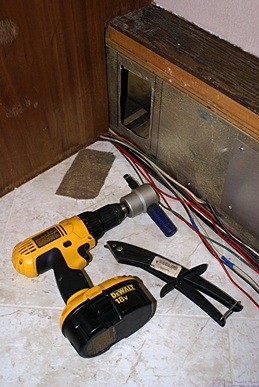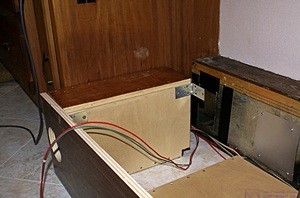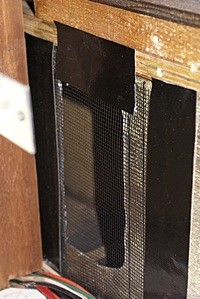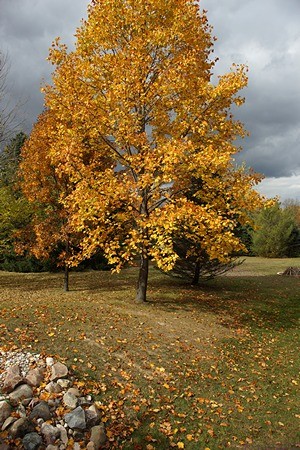We got up at 8 AM. I made Ethiopian Yirgacheffe half-caffe coffee while Linda prepared vegan pancakes. We had talked yesterday about going to the Howell Farmers Market this morning but did not feel like going out in the early morning chill. When we finished our coffee I turned the fireplace off and we got dressed to work.
Our focus in the bus today continued to be the built-in sofa. We decided yesterday to move the plywood seat out from the wall 4-3/4″ from its original position. The original stationary board on the back side of the piano hinge, which was only 2-3/4″ wide, was designed to place the front edge of the plywood seat (which has a 3/4″ walnut hardwood edge) 3/4″ beyond the cabinetry on both ends of the sofa with an overhang of just a few inches beyond the vertical front support board. It was a nice design which tied in well with the cabinetry and kept the sofa from intruding into the living room aisle. It resulted, however, in a seating depth of 16″ which turned out to be too short. It was my homage to Frank Lloyd Wright: integrated, attractive, cantilevered, and uncomfortable.
As much as I like and admire FLLW’s work, I also like the Bauhaus maxim “form follows function.” We needed a 3/4″ thick (11/16″ actually) board 7-1/2″ wide by 77-7/8″ long to locate the plywood seat in its new position. The only wood we had on hand that we could cut this from in one piece was a 24″ X 96″ piece of walnut veneered plywood. Since the board will not be visible I did not want to waste the walnut veneered plywood for this piece.
We also had a half sheet (4′ X 4′) of good plywood and after thinking about it for a while I decided to make the stationary board in two pieces. The key was that I would use a third piece, cut from that same 4′ X 4′ sheet, as a splicing plate to join the other two pieces together. But I was trying to accomplish more than that. With the original design the pivot line of the piano hinge was over the top of the wiring chase, about 1-3/4″ back from the front edge. That meant the back edge of the moveable seat board, when closed, was resting on the wiring chase for its entire length. With the new stationary board the pivot line of the piano hinge is unsupported except for 5-3/4″ on each end. The third piece of plywood would be at least a partial solution to that problem.
We worked in the garage with the overhead doors closed and the furnace on. I cut two 7-1/2″ wide pieces off of the 4′ X 4′ sheet of plywood and then cut them to lengths of 38-7/8″ each so they would be just shy of 77-7/8″ when butted together end-to-end. We took the two pieces to the bus and set them in place on top of the writing chase which sits atop the HVAC duct. They just fit, which was nice. I marked the underside along the edge of the wiring chase with a pencil. We then took the pieces back to the shop.
I found a relatively flat portion of the garage floor and laid the two pieces end-to-end face down. I set the third piece on top of the first two so that it was of equal length in both directions from the center and was at least 1/4″ forward from the line I had marked. This third board extended beyond the front edge of the other two boards by at least two inches along its entire length of four feet. With Linda holding it in place I inserted four self-drilling wood screws, two for each of the main boards, to hold the three pieces in position.
We placed the old 2-3/4″ wide board along the edge of the new boards and marked the locations of all of screw holes for the piano hinge. I then center punched and drilled countersunk holes for lots of screws being careful to keep them in between the hinge holes. I ran all of the screws in until the points just protruded from the other side. I then applied Titebond II wood glue to the two main boards, positioned the third board using the screw tips as alignment guides, and ran all of the screws down pulling the pieces tightly together. Linda got a paper shop towel wet and I used it to clean off the excess glue that oozed out from between the boards.
We took the new stationary backboard to the bus and set it in place upside down. I marked the underside along the edge of wiring chase and then we flipped it end-for-end and set it in place right side up. We pulled it forward so I could mark the locations of the existing screws securing the top of the wiring chase to the two long sides and then slid it back against the wall. The line served as my guide for where to screw the backboard to the wiring chase. (The chase has two long “1×2″ sides on edge with a 3/8″ thick plywood top that is about 4-1/2″ wide. For maximum strength I needed to screw through the backboard into the 1x2s. I also needed to avoid the space between the 1x2s as that is where all of the AC wiring is run.)
I center tapped a lot of locations and drilled them with a #6 countersink bit even though I was using #8 self-drilling outdoor screws. The reason for the drilling step was to make sure I did not split any wood. I screwed the backboard to the wiring chase with lots of 1-1/4″ #8 screws in two rows corresponding to the front and back side boards of the wiring chase.
The backboard pieces had oozed a small amount of additional glue so I used a piece of scrap aluminum sheet metal to scrap it out of the joint. When the plywood seat is closed the back couple of inches will rest on the third piece of plywood so there cannot be any interference along there. We set the moveable seat board in place and marked all of the hinge holes on the stationary backboard and then pulled it out gain. We did not, however, attach the piano hinge to the stationary backboard as I wanted to let the glue cure for at least 24 hours.
By this point it was 1 PM so we stopped to have lunch which consisted of vegan hotdogs with mustard, onions, and relish and both red and green grapes. We got these grapes at Meijer’s and their produce is usually good, but the green grapes had almost no taste. Oh well; there will be days (and foods) like that.
After lunch we shifted our attention to the driveway extension project. I gathered up a box of plastic and wood stakes, a mallet, a 100 foot tape measure, and the site plan for the bus barn and driveway. It took us about three hours to stake out the location of the pull-through driveway, locate the front corners of the bus barn, and stake out the approach/apron for the barn. Phil will be back early tomorrow morning and the first thing on the agenda is going over the layout and figuring out elevations for the two planned level pad areas.
At this point Linda went inside to work on dinner while I cleared the margin of the woods along the south side of the driveway extension. I added bar/chain oil and a 40:1 fuel:oil mixture to the chain saw and got out the compound loppers, pruning saw, pole saw, and safety glasses. I initially used the loppers to cut down small saplings, cut off small branches, and trim back bushes and vines. I used the chain saw to cut down slightly larger trees, up to 3” in diameter at the base, and finish cutting out three bushes and some entwined vines. I then used the pole saw to trim low overhanging branches. I dragged all of the cuttings to a spot on the west side of the fir trees and used the chain saw to cut the larger trees into smaller pieces.
It was 6:30 PM by the time I was done and had the tools put away. Dinner was almost ready when I got a call from Butch. He was following up on how our refrigerator was performing and also needed my assistance with a possible Ebay purchase. The item he was interested in was in Canton, Michigan about 45 minutes from our house, and the seller was not willing to ship it. He wanted to know if it would fit in our Honda Element and if so, would I be willing to pick it up if he decided to buy it. Of course I was willing to help as long as my car was able to handle the item. While he was on the phone I measured the clearance for the rear hatch and gave him the dimensions. As soon as we got off the phone he e-mailed me the link to the auction, which still had 85 minutes remaining.
For dinner Linda started with a really nice salad that had slivered almonds and pumpkin seeds and dressed it with Ken’s Sweet Vidalia Onion dressing. The main course was an amazing soup. She roasted a golden acorn squash, sweet potatoes, carrots, garlic, and shallots. She then put these in a pot, added vegetable broth, and heated the mixture. To finish the dish she used an immersion blender to purée everything into a smooth, thick, hearty, and delicious soup. After working outside all afternoon on a chilly day it really hit the spot. We finished the bottle of Cupcake Black Forest red wine we opened yesterday.
After dinner I retrieved Butch’s e-mail, checked out the item, and e-mailed him back. I then spent a little time reading and replying to posts in various RVillage groups. I called Butch back just before 8 PM and then turned on the Yaesu FTM-400 to join the SLAARC Info Net at 8 PM. Unfortunately all I heard was noise. I have not used the radio for the last few weeks so I don’t know if the net did not take place (unlikely but possible) or if a problem has developed with our system. If the later, it is most likely the Morgan I.C.E. lightning arrestor (again). Whatever the reason, I was not going to figure it out this evening. I went to bed at 9 PM and wrote this post. It took some time to write but if I do not record the details the same day they slip away quickly.



